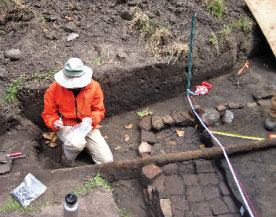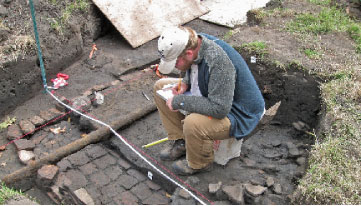
Sandra Massy of the
Anthropological Studies Center (ASC)
at Sonoma State University
takes samples near El Polin Spring
Photo: Kari Jones, Presidio Trust.
Ask which is the oldest building site in San Francisco from those in the know and you will get one of two answers: Mission Dolores or the Presidio.
While historians research the answer, members of the Archaeological Lab Program (ALP) at the Presidio of San Francisco are literally digging up the facts through fascinating relics that reflect life over three centuries.
The Presidio has been controlled by three different countries: Spain, which governed California from 1776 until 1821; Mexico from 1821 until 1846; and the United States since 1846. The Army turned the property over to the National Park Service in 1994.
Since the 1990s, the Presidio’s archaeological program has uncovered some intriguing history. In addition to site digs, archaeologists have relied on maps, documents, and written, visual and oral records to support their findings.
A report released in January 2010 begins with the description of how El Presidio was established in 1776 as a defense base and the northernmost outpost of colonial New Spain. Its boundaries originally extended from the Bay Area’s southern peninsula north to Santa Rosa, but its heart was a quadrangle that would become the future Main Post.
The oldest building is the Officers’ Club, which ALP restored by salvaging some adobe walls and flooring from its earliest days. This building almost did not become the Officers’ Club – the military’s annual report of 1857 described it as “objectionable as Officers’ Quarters, being dark, badly ventilated, damp, and muddy in winter, dusty in summer, and in disagreeable proximity to the barracks of enlisted men.” It was recommended as quarters for the laundresses.
Laundresses were hired for washing linens, but they may have served as cooks, maids or seamstresses as well. They were treated more as servants than employees and given the worst of the adobe residences. Because there is little information on the lives of these laundresses, ALP has made them a focus of continuing investigation.
ALP also hopes to examine the relative lack of information about the Mexican period. Given that recruitment for Presidio residents by Spain was primarily from Mexico, the lack of historical documentation is surprising.
Principal archaeologist Eric Blind attributes the shortage of information partially to the Gold Rush.
“I think because the Gold Rush was so transformative for San Francisco ... that it overshadows what came immediately before it. But I think that understanding what came before can add so much to our understanding of California,” Blind says.
A recent ALP project uncovered the foundations of a house, including pieces of a kiln and tiles. This discovery is significant, says Blind, because it belied the long-held theory that the tiles were shipped into the Presidio, when in fact they were made right on the premises. The resourcefulness and skills of early settlers became evident in this find.
Not surprisingly, officers lived the good life in the Presidio. During the Civil War, the War Department built single-family homes for the officers that faced west onto the parade ground. As San Francisco grew, the Army reoriented the homes to face east toward the city, possibly to avoid the fog and wind coming at residents from the west. Thus, Funston Avenue became the first streetscape in San Francisco. The reorientation also opened up valuable areas of buried artifacts that documented the lifestyles of officers and their families.
Another ALP expedition discovered a tunnel with water flowing toward San Francisco. While redesigning the Presidio Golf Course in the 1990s, the archaeologists hit a large hole, estimated to have existed since the 1850s. The Mountain Lake Water Company had developed a plan to divert water from Mountain Lake through the tunnel to Telegraph Hill, where it would provide water to San Francisco. It became clear, however, that there was never going to be enough water to satisfy the needs of the growing city, and the system was abandoned.
A remarkable discovery in the Montgomery Street barrack – which was rehabbed for the Walt Disney Family Foundation Museum – was little cubbyholes that soldiers used for decades. Found inside were alcohol containers hidden during Prohibition, permission slips to leave the base, and prescriptions for drugs to treat venereal disease.
El Polin Springs is a current project that archaeologist Blind says will afford visitors greater access to discoveries made at the site and to the landscape of the early Presidio.
El Polin is the central tributary of Tennessee Hollow, the Presidio’s largest watershed on the outskirts of the main quadrangle. ALP is set to restore and revitalize the entire watershed. Previous excavations had identified that the area included the homes of the Briones and Miramontes families in the early 1800s. Juana Briones was a formidable figure in the Bay Area during the 19th century.
According to Blind, the excavations at El Polin have the potential to enhance the visitors’ understanding of the Presidio’s many layers of history. Archaeological investigations in El Polin are an opportunity to show Bay Area students, from elementary through university levels, the value of archaeology through on-site research, as well as the interaction between plant growth and the natural heritage of the site.
“The Presidio Trust hopes to use [El Polin] as an outdoor archaeology classroom … the project will provide new, meaningful opportunities for public learning and exploration,” said Clay Harrell, Presidio Trust spokesperson.
On November 17, at 7 p.m., “El Polin and the Mexican Presidio” will be presented at the Officers’ Club. Presenters are ALP’s chief archaeologist Eric Blind, curator of archaeology Liz Clevenger, archaeologist Kari Jones; and Adrian Praetzellis, professor of anthropology at Sonoma State University.
Other members of ALP who have worked on the various projects include Katie Ahern, education and outreach coordinator; Camilla Rockefeller, archaeological technician; and Hans Barnaal, geographic information systems specialist.
For more detailed information, as well as volunteer opportunities and a list of partners, visit the ALP website at
www.presidio.gov/history/archaeology.




